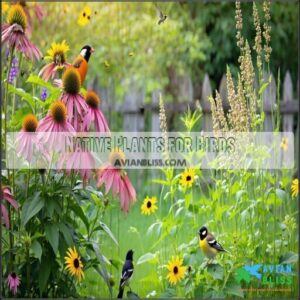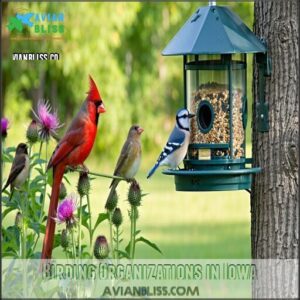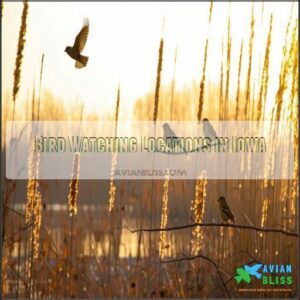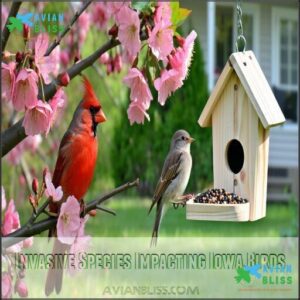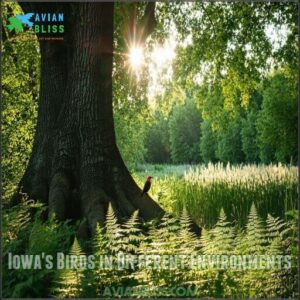This site is supported by our readers. We may earn a commission, at no cost to you, if you purchase through links.
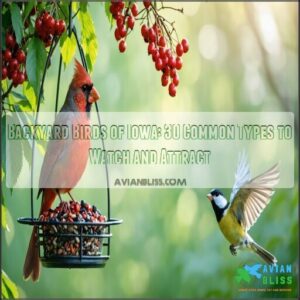
The bright red Northern Cardinal and cheerful Black-capped Chickadee stick around during winter, while Baltimore Orioles and Ruby-throated Hummingbirds visit in warmer months.
American Goldfinches (Iowa’s state bird) add splashes of yellow to your feeders.
Blue Jays announce their presence with loud calls, while Downy Woodpeckers quietly tap on trees.
You can attract these feathered neighbors with black oil sunflower seeds, suet, and native berry plants.
Each species has its own feeding preferences and behaviors – knowing these differences can transform your backyard into a bird paradise with the help of state bird.
Table Of Contents
- Key Takeaways
- Common Backyard Birds Found in Iowa
- Resident Birds of Iowa
- Identification Tips for Iowa Birds
- Attracting Iowa Birds to Your Yard
- Birding Organizations in Iowa
- Bird Watching Locations in Iowa
- Invasive Species Impacting Iowa Birds
- Iowa’s Backyard Birds Habitation Guide
- Iowa Birds’ Behavior, Migration, and Range
- Iowa’s Birds in Different Environments
- Frequently Asked Questions (FAQs)
- What are the most common backyard birds in Iowa?
- What are the most common backyard Feeder Birds in Iowa?
- Do you see birds at feeders or backyards in Iowa?
- Do birds eat native plants in Iowa?
- Can you see birds year-round in Iowa?
- What are the most common birds in Iowa?
- Where can I find common birds in Iowa?
- What is the best time to observe common birds in Iowa?
- What is the role of common birds in Iowa’s ecosystem?
- How can I attract common birds to my yard in Iowa?
- Conclusion
Key Takeaways
- Provide black oil sunflower seeds, suet, and native plants like berry bushes to attract a variety of Iowa’s backyard birds year-round.
- Learn to identify birds by focusing on size, plumage, beak shape, songs, and unique behaviors like chickadees’ "chick-a-dee-dee" calls or woodpeckers’ drumming sounds.
- Iowa’s backyard bird diversity includes year-round residents like Northern Cardinals and Black-capped Chickadees, as well as seasonal visitors like Ruby-throated Hummingbirds and Dark-eyed Juncos.
- Create a bird-friendly yard with feeders, fresh water, and native vegetation to support birds’ habitats, aid conservation, and enjoy year-round birdwatching opportunities.
Common Backyard Birds Found in Iowa
At least 17 varieties of Iowa backyard birds visit year-round, with the Northern Cardinal’s brilliant cardinal colors standing out against winter snow or summer greenery.
You’ll recognize males by their crimson plumage and females by their subtle reddish-brown highlights.
Black-capped Chickadees demonstrate fascinating chickadee behavior with their "chick-a-dee-dee" calls—each added "dee" warns of increasing danger to the flock.
American Robins feed primarily on worms and berries, their robin diet changing seasonally as they remain in Iowa throughout the year, becoming more visible in summer.
House Wrens prefer wren habitats with dense shrubs, while Mourning Doves announce dawn with soft, peaceful dove sounds.
For effective bird identification, look for Blue Jays’ striking bold crest and noisy calls, and American Goldfinches—Iowa’s state bird—that transform from dull olive in winter to bright yellow in summer.
Common birds in your Iowa backyard create a living nature show worth watching in every season.
Resident Birds of Iowa
You’ll find over 25 species of birds that call Iowa home throughout the year, including Northern Cardinals, Black-capped Chickadees, and the state bird, the American Goldfinch.
While some birds like the Northern Cardinal remain year-round residents, others such as Ruby-throated Hummingbirds visit only during summer months and Dark-eyed Juncos appear primarily in winter, making Iowa a diverse place for bird watching with its year-round visitors.
All-Year Birds
While Iowa hosts many seasonal visitors, you’ll find some faithful feathered friends sticking around all year long.
These year-round residents become familiar companions through every season’s change.
Iowa’s all-year birds bring continuous joy to your backyard:
- Northern Cardinals display remarkable Cardinal Behavior, maintaining territories year-round with males singing from high perches even during winter months
- Black-capped Chickadees follow a varied Chickadee Diet, switching from insects in summer to seeds and berries when cold weather arrives
- White-breasted Nuthatches prefer Nuthatch Habitat with mature trees, where they can be seen moving headfirst down trunks in search of insects
You’ll also regularly spot American Goldfinches (Iowa’s state bird), Downy Woodpeckers engaging in Woodpecker Nesting activities, and House Sparrows sharing their Sparrow Songs.
These yearround residents have adapted perfectly to Iowa’s changing seasons.
With black oil sunflower seeds and suet, these Iowa backyard birds will make your yard their permanent home regardless of weather.
Bird identification becomes easier as you observe their consistent presence.
Summer Visitors
While year-round feathered friends keep your backyard lively throughout the seasons, summer brings a vibrant wave of seasonal Iowa bird species to your yard.
Summer transforms Iowa yards into bustling airports as colorful seasonal visitors touch down for their warmest season stay.
From May through August, watch for the Red-winged Blackbird‘s distinctive call from tall grasses, easily identified by the male’s striking red shoulder patches. Ruby-throated Hummingbirds arrive for their breeding season, hovering around nectar-rich flowers. House Wrens return to build intricate nests in cavities, filling mornings with their bubbling songs.
The Gray Catbird, named for its cat-like mewing call, skulks through dense shrubs. Baltimore Orioles display their brilliant breeding plumage while constructing hanging nests in tall trees. Barn Swallows cruise overhead, catching insects mid-flight. Iowa’s summer months also host woodpeckers, where you might spot red-headed woodpeckers in your backyard.
These summer visitors establish temporary homes for raising juvenile birds before their fall migration patterns take them southward. Their insect diet helps control pest populations in your garden.
Winter Visitors
As snowflakes begin to fall across Iowa, a new squad of feathered visitors arrives for the winter season.
When temperatures drop, Dark-eyed Juncos—aptly nicknamed "snowbirds"—appear in flocks, their slate-gray backs contrasting beautifully against snowy landscapes.
These ground-feeders appreciate black oil sunflower seeds during harsh months.
Winter bird watching in Iowa rewards your patience with:
- Pine Siskins clustering around thistle feeders, their streaked bodies and yellow wing bars flashing as they feed
- American Tree Sparrows revealing their distinctive rusty caps and central breast spots while scratching beneath shrubs
- White-breasted Nuthatches performing gravity-defying, headfirst descents down tree trunks
For successful Winter Bird Habitats, maintain consistent feeding stations.
During particularly severe winters, you might spot rare visitors like Purple Finches or Evening Grosbeaks—exciting additions to your winter bird watching experience.
Identification Tips for Iowa Birds
Throughout the seasons, identifying local birds becomes easier by focusing on key characteristics. Study Bird Size first—compare to familiar objects. Notice Plumage Variations between males, females, and juvenile birds. Observe Beak Shapes that indicate diet preferences.
Listen for distinctive Bird Songs and watch unique Flight Patterns to build your bird identification skills. Ignoring vocalizations can lead to misidentification.
- Black-capped Chickadees bounce through flight with their "chick-a-dee-dee" call
- American Goldfinches show dramatic seasonal changes from dull winter to bright summer colors
- Northern Cardinals maintain their crest shape during different activities
- White-breasted Nuthatches creep headfirst down tree trunks unlike other Iowa birds
Keep a bird guide handy for reference.
Attracting Iowa Birds to Your Yard
You’ll transform your Iowa yard into a vibrant avian haven by providing the right combination of food sources, water features, and native vegetation that attract our state’s diverse bird species.
With strategic placement of feeders, baths, and indigenous plants like coneflowers and serviceberry, you’ll create a sanctuary that welcomes everything from year-round Northern Cardinals to seasonal visitors like Ruby-throated Hummingbirds.
Bird Feeders and Bath Tips
Setting up proper bird feeders and baths can transform your yard into a haven for Iowa birds. Position feeders either within 3 feet or beyond 10 feet from windows to prevent collisions.
Different species prefer specific feeder types – tube feeders attract finches, hopper styles bring in cardinals, and suet cages invite woodpeckers.
For ideal results, match seeds to your target birds:
- Black oil sunflower: Cardinals, chickadees
- Nyjer (thistle): Goldfinches
- Suet cakes: Woodpeckers, nuthatches
Clean feeders monthly with a 10% bleach solution to prevent disease spread.
Bird baths are equally essential – moving water features attract more species, while heated baths provide vital winter hydration when natural water sources freeze. Consider exploring options for Iowa bird feeders to enhance your backyard setup.
For ideal placement tips, install feeders near protective cover but with clear sightlines so birds can watch for predators while feeding.
Native Plants for Birds
While feeders offer quick snacks, native plants create sustainable bird habitats in your Iowa yard.
Plant these local favorites to attract our feathered friends:
- Purple coneflowers and black-eyed Susans provide seed sources for goldfinches and chickadees year-round.
- Berry bushes like elderberry offer natural food that cardinals can’t resist.
- Wild bergamot creates insect attraction zones, supplying protein-rich food for nesting birds.
- Prairie grasses deliver both shelter benefits and seeds for ground-feeding juncos.
You’ll support bird conservation while enjoying more visitors than with feeders alone.
Native plants require less maintenance and naturally match Iowa birds’ diet preferences.
You can find Iowa native plant products to get started, and by doing so, you will be creating a natural food source and shelter for the birds.
Birding Organizations in Iowa
Get involved in Iowa birdwatching by joining organizations like the Iowa Audubon Society, Iowa Ornithologists Union, or Bird Friendly Iowa. These groups run field trips, educational programs, and citizen science initiatives to monitor bird populations and conserve habitats.
You’ll find opportunities to volunteer, connect with others, and make a difference in Iowa bird conservation. Habitat loss substantially impacts bird populations, making local conservation efforts essential.
| Organization | Focus Areas | Opportunities |
|---|---|---|
| Iowa Audubon Society | Conservation Partnerships | Field Trips, Monitoring |
| Iowa Ornithologists Union | Citizen Science | Research Projects |
| Bird Friendly Iowa | Bird-Safe Environments | Community Initiatives |
| Local Birdwatching Clubs | Educational Programs | Workshops |
| Bird Conservation Groups | Wildlife Refuges | Volunteering |
For more information on bird conservation organizations near you, visit Habitat loss to learn about the impact of habitat loss on bird populations and how local conservation efforts are crucial for their survival.
Bird Watching Locations in Iowa
You’ll find excellent bird watching opportunities across Iowa’s diverse landscapes, from the water-rich habitats of Saylorville Reservoir to the protected wetlands of Otter Creek Marsh Wildlife Area.
These locations offer prime viewing spots where you can observe Iowa’s resident and migratory bird species in their natural environments, which is a key aspect of Iowa’s diverse landscapes.
Saylorville Reservoir
Saylorville Reservoir ranks among Iowa’s top birdwatching hotspots, offering a perfect field trip after connecting with local birding organizations. This 17-mile reservoir on the Des Moines River hosts over 325 species within the Central Flyway’s migration patterns.
You’ll discover remarkable waterfowl abundance year-round as the U.S. Army Corps of Engineers manages water levels to maintain ideal wetland habitat.
Plan your visit according to these seasonal highlights:
- Spring: Search for Piping Plovers, Caspian Terns, and 25+ warbler species
- Summer: Photograph egrets, herons, and Osprey fishing along shorelines
- Fall: Track Red-throated Loons and migrating sandpipers
- Winter: Witness Bald Eagles soaring above ice-free sections
For the best Iowa wildlife viewing experiences:
- Visit Jester Park’s bird blind for close-up observation
- Check the dam’s pull-offs for scanning open water
- Bring spotting scopes for distant reservoir birdlife
- Arrive early morning for peak activity
Habitat conservation efforts protect this birdwatching paradise despite recreational impact.
Otter Creek Marsh Wildlife Area
While Saylorville offers lakeside viewing, Otter Creek Marsh Wildlife Area presents a different birding experience with its extensive wetland habitat.
This 3,500-acre conservation area showcases Iowa’s commitment to habitat management and wetland preservation.
| Bird Species | Best Season | Habitat Type | Viewing Tips |
|---|---|---|---|
| Red-winged Blackbird | Spring-Summer | Cattail Marshes | Listen for distinctive calls |
| Great Blue Heron | Year-round | Shallow Waters | Dawn provides best light |
| Wood Duck | Summer | Wooded Wetlands | Check nesting boxes |
| Sandhill Crane | Migration | Open Marsh | Bring spotting scope |
You’ll find excellent public access points with observation platforms that make this Iowa birdwatching hotspot perfect for viewing waterfowl abundance in their natural environment.
Invasive Species Impacting Iowa Birds
While exploring Iowa’s diverse bird watching locations, you’ll also encounter several non-native species that impact the local bird population.
Invasive birds pose significant challenges to Iowa’s native species, including:
- House Sparrows aggressively take over nesting cavities, sometimes killing native birds like bluebirds and chickadees
- European Starlings compete relentlessly for food and habitat, pushing out woodpeckers and other cavity-nesters
- Disease transmission occurs when invasive species spread avian diseases to native populations
- Habitat displacement forces indigenous birds from their traditional territories.
These invasive species constitute less than 5% of Iowa’s breeding birds, yet House Sparrows and European Starlings rank among the three most abundant bird species in the state, particularly impacting farms through waste contamination and disease spread.
You can help protect native birds by installing starling-proof birdhouses with 1½-inch entrance holes and using feeders that discourage invasive species while supporting native populations.
Iowa’s Backyard Birds Habitation Guide
You’ll find Iowa’s diverse bird species inhabiting specific ecological zones that include open fields, dense woodlands, and various wetland areas throughout the state.
Understanding these habitat preferences will help you create targeted backyard environments that attract the exact species you want to observe.
Open Fields and Meadows
Iowa’s open fields and meadows provide essential habitat for numerous grassland birds. Eastern Meadowlarks and Dickcissels thrive in these spaces, using tall grasses for both feeding and nesting sites.
You’ll spot Red-winged Blackbirds perched on swaying stalks, announcing their territory with distinctive calls.
- Plant native prairie grasses like big bluestem and wildflowers such as coneflowers to recreate meadow habitats in your yard.
As agricultural expansion reduces natural grasslands, these birds face habitat challenges. By maintaining even small patches of meadow in your landscape, you’re supporting Iowa wildlife and their foraging ecology while creating excellent birdwatching locations.
Forests and Woodlands
While open fields attract their own bird species, Iowa’s forests and woodlands harbor a different community of feathered residents.
These wooded areas support remarkable diversity through layered habitats from forest floor to canopy.
Your backyard woodland can attract these birds with proper habitat elements, including Forest Bird Diets and Woodland Nesting Habits. Many species rely on specific diets – chickadees consume insects from bark crevices while cardinals prefer seeds and berries.
Woodland birds also exhibit unique behaviors, such as woodpeckers excavate cavities that later benefit other species. Consider installing bird houses that mimic natural tree hollows to support these birds.
Wetlands and Waterways
While forests provide shelter for many species, wetlands and waterways host another fascinating array of Iowa birds.
Though 95% of original wetland ecosystems have disappeared, remaining aquatic habitats support diverse waterbird communities.
You’ll spot these water-loving species in Iowa’s wetlands:
- Great Blue Herons stalking fish with remarkable patience
- Wood Ducks nesting in tree cavities near river habitats
- American White Pelicans gathering on larger waterways
- Baltimore Orioles weaving hanging nests near water sources
- Blue-winged Teal splashing in shallow marsh areas
Adding a simple birdbath to your yard connects your space to these wetland visitors, supporting shorebird migration and wetland conservation efforts.
Iowa Birds’ Behavior, Migration, and Range
Nearly one billion birds transform your backyard landscape as they travel the Mississippi Flyway through Iowa each year.
Spring migration peaks from mid-April to early May, while fall migration stretches from August through mid-December at a more leisurely pace.
You’ll notice fascinating social behavior among Iowa wildlife – Black-capped Chickadees form small, vocal groups while Blue Jays loudly announce their territory.
Northern Cardinals demonstrate different feeding habits, quietly foraging in dense cover.
- **Regular backyard feeding has actually changed migration patterns for some species, with American Goldfinches (Iowa’s state bird) now staying through winter thanks to reliable food sources.
Bird migration typically begins shortly after sunset, with species like Ruby-throated Hummingbirds traveling incredible distances from Central America to establish mating rituals and roosting patterns in your backyard.
Iowa’s Birds in Different Environments
Iowa’s diverse landscapes house five distinct bird communities across the state.
You’ll spot different species depending on where you explore:
| Environment | Common Birds | Habitat Features | Best Viewing Times |
|---|---|---|---|
| Grasslands | Eastern Meadowlarks, Dickcissels | Tall grasses, open fields | Dawn, early summer |
| Wetlands | Red-winged Blackbirds, Great Blue Herons | Cattails, shallow water | Spring migration |
| Woodlands | Woodpeckers, Warblers | Mature trees, understory | Year-round |
| Urban Areas | House Finches, Robins | Parks, gardens, feeders | Morning, evening |
Climate change effects are reshaping these Iowa ecosystems, with some species shifting their ranges northward.
Rural habitats typically host greater diversity than urban bird habitats, though dedicated birdwatching hotspots exist in both.
Woodlands are especially important, offering mature trees for nesting, which is crucial for woodpeckers and other species, highlighting the need to preserve these ecosystems and understand the impact of climate change on bird communities and their habitats.
Frequently Asked Questions (FAQs)
What are the most common backyard birds in Iowa?
You’ll commonly spot American Robins, Red-winged Blackbirds, Northern Cardinals, Mourning Doves, and House Wrens in your Iowa backyard.
Black-capped Chickadees, American Goldfinches, and Blue Jays also make frequent appearances throughout the year, which includes Northern Cardinals.
What are the most common backyard Feeder Birds in Iowa?
You’ll commonly find Northern Cardinals, Black-capped Chickadees, American Goldfinches, Blue Jays, and White-breasted Nuthatches visiting your Iowa feeders year-round.
Dark-eyed Juncos appear in winter, while Ruby-throated Hummingbirds visit during summer months, which is a notable time for year-round visitors to change.
Do you see birds at feeders or backyards in Iowa?
Yes, you’ll spot many birds at Iowa feeders year-round, including Northern Cardinals, Black-capped Chickadees, and American Goldfinches. In summer, you’ll also see Ruby-throated Hummingbirds and Baltimore Orioles visiting regularly.
Do birds eat native plants in Iowa?
Fluttering among native blooms, Iowa’s birds enthusiastically feast on berries, seeds, and nuts from local plants.
You’ll notice chickadees requiring 6,000 caterpillars that thrive on native species.
They’ve evolved together for millions of years.
Can you see birds year-round in Iowa?
You’ll see birds in Iowa throughout all seasons.
Many species like Northern Cardinals, Black-capped Chickadees, and American Goldfinches stay year-round, while others visit seasonally, creating constant birdwatching opportunities regardless of the month.
What are the most common birds in Iowa?
Like treasures in your backyard, Iowa’s most common birds include American Robins, Red-winged Blackbirds, Northern Cardinals, Mourning Doves, and House Wrens.
You’ll also frequently spot Black-capped Chickadees and American Goldfinches year-round, which are part of the common birds seen in the area.
Where can I find common birds in Iowa?
You’ll find common Iowa birds in your own backyard, local parks, nature preserves, and wooded areas.
Set up bird feeders near windows to attract cardinals, chickadees, and goldfinches throughout the year.
What is the best time to observe common birds in Iowa?
Birds are nature’s early risers.
Dawn during spring and summer offers prime viewing when species like American Robins and Northern Cardinals are active.
Winter mornings reveal quieter visitors like Dark-eyed Juncos, perfect for peaceful observation, and offer a chance to see birds in a more serene environment, making it ideal for nature lovers.
What is the role of common birds in Iowa’s ecosystem?
Common birds in Iowa help control pests, spread seeds, and pollinate plants.
They balance ecosystems by eating harmful insects and supporting plant growth.
Their presence makes your environment healthier, keeping nature’s cycles running smoothly, and they play a crucial role in maintaining a healthier environment.
How can I attract common birds to my yard in Iowa?
Provide fresh water, native plants, and feeders with seeds or suet to attract Iowa’s birds.
Offer shelter like shrubs or birdhouses.
Keeping the yard tidy but natural creates a welcoming haven for feathered visitors.
Conclusion
Imagine your backyard as an orchestra, each bird species adding its unique melody.
By learning about the backyard birds of Iowa and their habits, you can create a haven that attracts cardinals, goldfinches, orioles, and more.
Provide black oil sunflower seeds, suet, and native plants to meet their varying needs.
Observe their behaviors, note migratory patterns, and watch your yard transform into a lively sanctuary.
With care and attention, your backyard can become Iowa’s perfect avian retreat.




